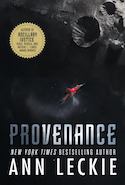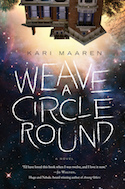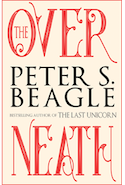Future Alternative Past: impeccable taste
Every month, Nisi Shawl presents us with news and updates from her perch overlooking the world of science-fiction, fantasy, and horror. You can also look through the archives of the column.
Magellanic pseudopods and chipped funkleweed
Food in space! It isn’t always as vividly and goofily named as the cafeteria offerings listed above, lifted from the infamous Pel Torro’s godawful novel Galaxy 666. In fact their polar opposite, the tasteless and efficient food pills are fairly ubiquitous; they make an appearance as early as the Victorian SF story “The Senator’s Daughter” and are heavily featured in Twentieth Century media such as the cartoon series The Jetsons. The closest supermarket reality ever came to the dream of full nutrition in an easy-to-swallow pill was “Space Food Sticks,” a forerunner of modern protein bars which tasted like sweetened library paste mixed with chalk dust and rolled into brown cigar-shapes between dirty, sweaty palms.
Soylent Green, the mysteriously complete protein in wafer form whose ingredients are the icky crux of the 1970s movie of the same name, inspired Soylent brand “meal replacement” powders and drinks. Apparently the recipe for this version differs significantly from the cinematic one.
Vat-grown or printed meat such as Frederik Pohl’s immortal Chicken Little are often presented in SFFH as the food of the plebian masses: cheap and unappetizing, a sort of edible handjob. But they also stir up consideration of ethical questions around vegetarianism, the necessity for the suffering of living beings, and the negative environmental impact of traditional agriculture. The snobbishness evinced against faux foods is at times reversed, with one Jack Vance character, an advanced traveler to parallel dimensions, nauseated at the prospect of having to consume “the enlarged sexual organs of plants.”
But aesthetic issues aren’t always at the forefront of reasons given by SFFH characters for eating artificial meat. The closed ecology envisioned for most interstellar vessels necessitates it. And the low probability of finding nutritionally adequate foodstuffs off Earth necessitates it for longer than the duration of voyages already lasting years, decades, even generations. Working models based on truly rigorous planet-level biochemistry yield systems like that of Kim Stanley Robinson’s Aurora — unfamiliar forms of life inimical to our own. Various authors have dealt with this problem in various ways, including ignoring it, attributing its absence to a panspermian history of the universe, committing their fictional populaces to the eternal operation of huge hydroponics farms, and combinations of all three tactics.
The atevi homeworld described in C.J. Cherryh’s Foreigner series is a somewhat gentler version of the hostile planet-wide habitat; certain spices favored by the natives are pukingly poisonous to colonizing humans. Cherryh’s linguist hero Bren Cameron succumbs to near-fatal food pranking in one of the many nastily humorous cultural clashes she depicts.
A Jewish friend once remarked on the anthropology of keeping kosher, “The best way of maintaining a distinct tribal identity is to have strict rules about what you can and cannot eat, and how, and when, and where…If you can’t share a casual meal with your neighbors, you’re not going to share much else.” SFFH comestibles — including some arguably sentient beings — maintain the genre’s tribal identity by getting us to think about eating in familiarly estranged ways.
Recent books recently read

Take, for instance, Provenance (Orbit), Ann Leckie’s standalone follow-up to her multiple-award-winning Imperial Radch trilogy (Ancillary Justice, Ancillary Sword, and Ancillary Mercy). Both high and low class characters eat “nutrient blocks,” though only a former prisoner thinks to hoard them against possible hard times ahead. Provenance is the story of Ingray Aughskold, who stands to inherit her adoptive mother’s wealth, power, and eventually her identity. Between slurping down rehydrated noodles and munching nutrient blocks, Aughskold attempts to execute her daring plan to outshine her brother, the rival for their mother’s heirship. It’s an involved scheme centering on the theft and forgery of “vestiges,” super-sought-after memorabilia collected obsessively in Aughskold’s corner of the fictional Imperial Radch universe. But the plan has far too many moving parts, plus Leckie portrays her heroine as a bit of a klutz, always losing hairpins and accepting villains at face value. Her plan fails — entertainingly, of course. Add a Jack Vanceian flair for futuristic styles of dress and speech and Leckie’s trademark use of pronouns to matter-of-factly deconstruct the gender binary and you have a valiant successor to that rightfully much-vaunted debut trilogy.

Critics and publicists compare newcomer Kari Maaren, author of Weave a Circle Round (Tor), to Madeleine L’Engle and E.L. Konigsburg. This debut novel certainly introduces readers to charmingly eccentric characters similar to those these vintage authors wrought. But it has its thoroughly modern elements as well: gaming is a legitimate creative venture; mixed race backgrounds are truly background; and blended families are equally unremarkable. The plot resonates nicely with typical youthful angsty outsiderness: 11-year-old protagonist Freddy Duchamp inadvertently goes time-traveling with one of her new nonhuman neighbors and discovers that her sad inability to conform may not be such a handicap as she thought it was…and that her pedantic baby sister and their barely tolerated stepbrother can help her outsmart archetypes-gone-wild who want to rule over her by virtue of the power of storytelling.

Peter S. Beagle, author of The Overneath (Tachyon) knows that power well, and wields it with the skill of a lifelong practitioner. Though the thirteen stories collected in this latest volume probably won’t change the lives of millions and provide a generation with its standard for what fantasy ought to accomplish — which his classic novel The Last Unicorn most assuredly did — they are lovely, strange, and an utter, heartwrenching joy. Two, “The Green-Eyed Boy” and “Schmendrick Alone,” are Last Unicorn prequels, telling how that book’s belovedly klutzy magician set off and limped along his career path. “Olfert Dapper’s Day” draws on material Beagle found when researching historic unicorn appearances. But my favorite story is the one featuring real-life author and shameless eccentric Avram Davidson, “The Way It Works Out and All.” Perhaps that’s because I so admire its subject, or perhaps it’s because Beagle’s clear-eyed-remembrance-cum-cautionary-tale perfectly sums up how reading this collection feels: like wandering through the Overneath that is its title, the reality between our many worlds.
Couple of upcoming cons
Don’t be fooled by the name: Anglicon is and always has been a decidedly local event. It will take place this coming December in SeaTac’s Doubletree hotel, the “Angli-” content provided, as is customary, by Guests of Honor and programming. Not one but two former Dr. Whos are coming — the fifth and seventh; Anglicon’s panels and masquerade will also reflect volunteers’ fascination with British TV-and-film-based SFFH. Proceeds benefit an area PBS station and British media purveyor.
Smofcon is a sort of meta-convention. In SFFH fanspeak, “smof” derives from the collapse of an ironic acronym standing for “Secret Master of Fandom.” Smofs run cons and other vital SFFH functions, and at Smofcon 35 in Boston this December, Massachusetts Convention Fandom, Inc. will present panels on the best ways to do that. Want to learn how to pick good Guests of Honor? How to run an inclusive event welcoming to all races, abilities, and genders? These folks can help.